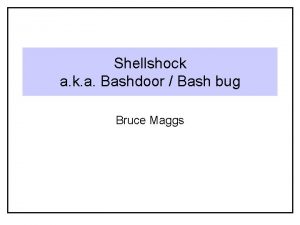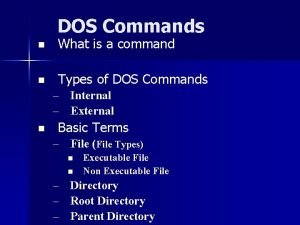UNIX find command The find command is used














- Slides: 14

UNIX

find command ● The find command is used to locate files on a Unix or Linux system. find will search any set of directories you specify for files that match the supplied search criteria ● Syntax: find where-to-lookup criteria/filename ● Wild cards: find /tmp fi*

find command ● ● We can use this command to find out files which were modified in last 10 minutes find. -mmin -10 ● The above lists all the files in current directory which wer ● modified 10 minutes back ● ● find. -mtime 0 # find files modified between now and 1 day ago # (i. e. , within the past 24 hours) find. -mtime -1 # find files modified less than 1 day ago

find command find. -name '*' -size +1 M In the above example the system would search for any file that is larger then 1 MB. ● ● find. will display the path names of all files in the current directory and all sub directories.

Processes ● ● A process is a program in execution. Every time you invoke a system utility or an application program from a shell, one or more "child" processes are created by the shell in response to your command. All UNIX processes are identified by a unique process identifier or PID. We have one command to display current running processes ● ps ● Options: ps -all ● ps -ef

kill command ● ● kill command is used to terminate a running process ● kill -9 PID ● PID: Process ID

wc command ● ● wc command is used to count how many lines, words, and characters there are in a file syntax : wc filename

tar command ● Create Tape ARchives (TAR) and add or extract files. ● Options: tar [options] filename. tar filename ● ● ● Creating a tar file: tar -cvf file. tar file Extracting the files from a tar file: tar -xvf file. tar

Compress a file/directory ● tar -zcvf archive-name. tar. gz directory-name ● Where, ● -z: Compress archive using gzip program ● -c: Create archive ● ● ● -v: Verbose i. e display progress while creating archive -f: Archive File name tar -zxvf archive-name. tar. gz

gzip command ● ● ● ● gzip reduces the size of the files To compress a file with gzip, pass the filename as an argument: gzip file. txt To uncompress, use gunzip: gunzip file. txt. gz or gzip -d file. txt. gz

grep command ● ● The grep command allows you to search one file or multiple files for lines that contain a pattern. Grep “string” filename ● If any match found it displays “string”. ● If not it wont display any thing ● Case insensitive search using grep -i ● Syntax: grep -i "string" FILE

uname ● uname: command is used display operating system information ● it gives name, version and 32 bit/64 bit of the operating system ● x 86_64 when it is an kernel 64 bits ● i 686 for 32 bits kernel

Questions? ? ?

Thank You
 Internal command in unix
Internal command in unix Printenv.pl exploit
Printenv.pl exploit Command line arguments in unix
Command line arguments in unix Which command is used to set terminal io characteristic
Which command is used to set terminal io characteristic Pencil tool image in ms paint
Pencil tool image in ms paint The vol command is used to
The vol command is used to Hình ảnh bộ gõ cơ thể búng tay
Hình ảnh bộ gõ cơ thể búng tay Bổ thể
Bổ thể Tỉ lệ cơ thể trẻ em
Tỉ lệ cơ thể trẻ em Voi kéo gỗ như thế nào
Voi kéo gỗ như thế nào Tư thế worms-breton
Tư thế worms-breton Alleluia hat len nguoi oi
Alleluia hat len nguoi oi Các môn thể thao bắt đầu bằng tiếng bóng
Các môn thể thao bắt đầu bằng tiếng bóng Thế nào là hệ số cao nhất
Thế nào là hệ số cao nhất


























